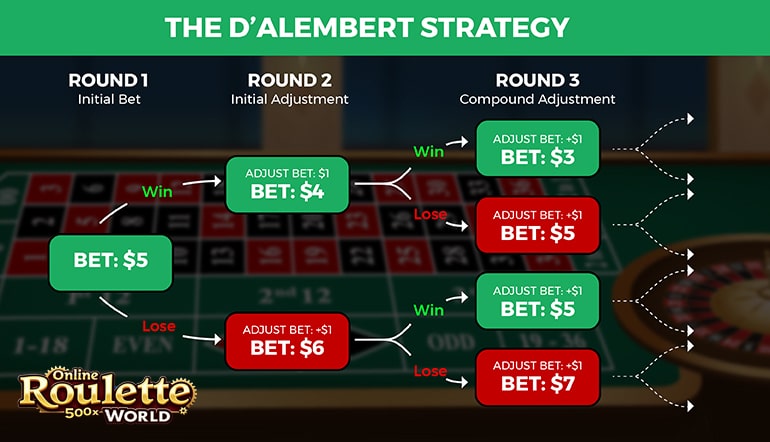D’Alembert Roulette Strategy
Roulette is a game of chance that has captivated players for centuries, offering the thrill of potential big wins and the allure of beating the odds. Among the many betting strategies developed for roulette, the D’Alembert system stands out as a more conservative approach compared to the aggressive Martingale system.
Devised by the French mathematician Jean-Baptiste le Rond d’Alembert, this roulette wheel strategy focuses on even-money bets, such as red/black, odd/even, or high/low. The core principle of the D’Alembert strategy is to increase the bet by a fixed amount after a loss and decrease it by the same amount after a win. This approach aims to gradually recoup losses and protect winnings, making it a medium-risk strategy for roulette players.

In this article, we will delve into the intricacies of the D’Alembert Roulette Strategy, exploring its underlying logic, practical implementation, and the potential advantages and disadvantages it presents. By understanding the nuances of this system, players can make informed decisions about incorporating it into their roulette gameplay and develop a well-rounded understanding of the various betting strategies available.
What is the D’Alembert Roulette Strategy?
The D’Alembert Betting Strategy is a system that aims to provide a more conservative and balanced approach to roulette gameplay. Developed by the French mathematician Jean-Baptiste le Rond d’Alembert, this system is based on the principle of “chasing losses” and “protecting wins.”
The core idea behind the D’Alembert system is to adjust the bet size in a specific manner after each outcome. The strategy dictates that you should increase your bet by a fixed amount (e.g., $5) after a loss and decrease it by the same fixed amount after a win. This gradual adjustment of the bet size is intended to help you recoup losses and maintain a steady growth of your bankroll.
Unlike the Martingale system, which doubles the bet after each loss in an attempt to recover losses quickly, the D’Alembert system employs a more moderate approach. This makes it a medium-risk strategy, as it aims to minimize the potential for catastrophic losses while still offering the possibility of steady, incremental gains.

The D’Alembert system is primarily used for even-money bets in playing roulette, such as red/black, odd/even, or high/low. These bets have a nearly 50% probability of winning, which aligns well with the strategy’s goal of gradually recouping losses and protecting winnings.
How to Implement the D’Alembert Strategy in Roulette?
Implementing the D’Alembert Online Roulette Strategy is a straightforward process that requires discipline and adherence to the system’s principles. Here’s a step-by-step guide on how to apply the D’Alembert strategy in your roulette gameplay:
- Determine your starting bet and fixed increment: Before you begin, decide on a starting bet amount, such as $15, and a fixed increment, for example, $5. These values will serve as the foundation for your betting adjustments.
- Place your initial bet: Place your starting bet of $15 on an even-money online roulette bet, such as red/black, odd/even, or high/low.
- Adjust your bet based on the outcome:
- If you lose the bet, increase your next bet by the fixed increment of $5, making your next bet $20.
- If you win the bet, decrease your next bet by the fixed increment of $5, making your next bet $10.
- Repeat the process: Continue to adjust your bet by one unit size up or down by the fixed increment of $5 after each win or loss, respectively.
- Monitor your bankroll: It’s crucial to keep a close eye on your bankroll and set a predetermined loss limit. The D’Alembert strategy can be susceptible to extended losing streaks, so it’s important to know when to walk away and preserve your bankroll.
- Consider the table minimum: Be mindful of the table minimum, as it may impact your ability to adjust your bet size according to the D’Alembert system. If the table minimum is higher than your current bet, you may need to adjust your starting bet and increment accordingly.
- Maintain discipline: The success of the D’Alembert strategy relies heavily on your discipline and adherence to the system. Resist the temptation to deviate from the prescribed betting adjustments, as this can undermine the strategy’s effectiveness.

Pros and Cons of the D’Alembert System
Like any roulette betting strategy, the D’Alembert system has its own set of advantages and disadvantages that players should consider before adopting it. Understanding the potential benefits and drawbacks can help you make an informed decision about whether this system aligns with your gambling preferences and risk tolerance.
Pros of the D’Alembert System:
- Relatively Low Risk: Compared to more aggressive strategies like Martingale, the D’Alembert roulette system is considered a medium-risk approach. The gradual adjustments to the bet size help mitigate the potential for catastrophic losses.
Gradual Bankroll Growth: The D’Alembert system’s approach of incrementally increasing or decreasing the bet size can lead to a more steady and sustainable growth of your bankroll, rather than relying on large, potentially unsustainable wins. - Extended Play Sessions: The D’Alembert system’s moderate betting adjustments allow for longer play sessions, as it is less likely to deplete your bankroll as quickly as high-risk strategies.
- Simplicity: The D’Alembert system is relatively straightforward to understand and implement, making it accessible to both novice and experienced roulette players.
Cons of the D’Alembert System:
- Susceptibility to Losing Streaks: While the D’Alembert system is designed to mitigate losses, extended losing streaks can still quickly deplete your bankroll, as the incremental increases in bet size can add up rapidly.
- Slower Pace of Potential Winnings: Compared to high-risk strategies that aim for large, rapid gains, the D’Alembert system’s more conservative approach may result in a slower pace of potential winnings.
- Requires Discipline: Successful implementation of the D’Alembert system requires unwavering discipline in following the prescribed betting adjustments. Deviating from the system can undermine its effectiveness.
- Potential Limitations at Low Table Minimums: If the roulette table’s minimum bet is significantly higher than your starting bet, it may become challenging to adhere to the D’Alembert system’s incremental adjustments.
Conclusion
The D’Alembert Strategy wiki offers roulette players a compelling alternative to more aggressive betting systems. Developed by the French mathematician Jean-Baptiste le Rond d’Alembert, this system provides a balanced and controlled approach to the game, focusing on even-money bets and gradual adjustments to the bet size.
By increasing the bet by a fixed amount after a loss and decreasing it by the same amount after a win, the D’Alembert system aims to gradually recoup losses and protect winnings. This moderate approach makes it a medium-risk strategy, appealing to players who prioritize extended play sessions and sustainable bankroll growth over the potential for rapid, high-stakes gains.

While the D’Alembert system is not without its drawbacks, such as susceptibility to extended losing streaks and a slower pace of potential winnings, it presents a viable option for roulette enthusiasts seeking a more conservative and disciplined betting strategy.
As you explore the world of roulette betting strategies, we encourage you to carefully consider the D’Alembert system and its suitability for your personal gambling preferences and risk tolerance. By understanding the nuances of this strategy and its potential advantages and disadvantages, you can make an informed decision about incorporating it into your roulette gameplay.
FAQs
What is the core principle of the D’Alembert Roulette Strategy?
The D’Alembert system is based on the principle of increasing the bet by a fixed amount (e.g., $5) after a loss and decreasing it by the same fixed amount after a win. This approach aims to gradually recoup losses and protect winnings.
What type of bets does the D’Alembert system work best with?
The D’Alembert system is primarily used for even-money bets in roulette, such as red/black, odd/even, or high/low. These bets have a nearly 50% probability of winning, which aligns well with the strategy’s goal of gradual bankroll growth.
Is the D’Alembert system a low-risk or high-risk strategy?
The D’Alembert system is considered a medium-risk strategy, as it is more conservative compared to aggressive systems like the Martingale. While it can help mitigate the potential for catastrophic losses, it is still susceptible to extended losing streaks that can deplete the bankroll.
How much capital do I need to implement the D’Alembert strategy effectively?
It’s recommended to have a bankroll of at least $1,000 when using the D’Alembert system. This allows for a sufficient buffer to withstand potential losing streaks and provides the flexibility to adjust the bet size as per the strategy’s requirements.
Can the D’Alembert system guarantee profits in roulette?
No, the D’Alembert system, like any other roulette betting strategy, does not guarantee profits. It is designed to provide a more balanced and controlled approach, but it does not eliminate the inherent house edge in roulette. Consistent profits can never be assured in casino games.
How do I know when to stop using the D’Alembert system?
It’s important to set predetermined loss limits and stick to them. If you experience an extended losing streak that depletes a significant portion of your bankroll, it may be prudent to step away and reevaluate your strategy or take a break from gambling.
